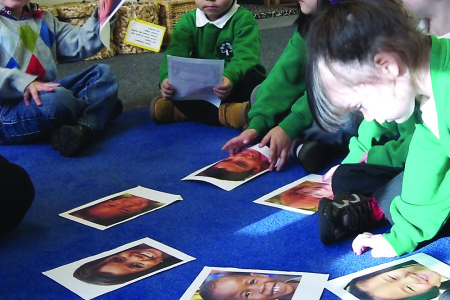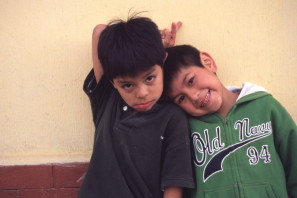Our working group, formed for the Quality or Quantity project, drew teachers from several nurseries (age 3–5) and infant schools (age 5–7) in north Hampshire. Our intention was to explore ways to measure attitudes in Foundation Stage pupils (age 3–5) linked to all the Global Citizenship key concepts. Group members were teaching in a diverse set of schools: from an area of deprivation in Farnborough to fairly affluent, mainly white British areas near Basingstoke. Some activities were trialled with a small New Forest village school.
Developing a new activity
One of the teachers initially created an activity, similar to Who would you choose to be your friend, but with 10 photos that included disability, obesity and disfigurement, and used age-relevant images. The activity was trialled with her Reception class of 30 children aged 4. Questions included:
Would you want this person as a friend? Why? Why not?
Would you play with this person? Why? Why not?
Would this person choose you as a friend? Why? Why not?
Would this person play with you? Why? Why not?
It was felt that with this age group individual interviews would elicit more reliable responses than a group activity, where pupils tend to copy one another. Most chose white children with no obvious disability or disfigurement.
The Working Group discussed modifying the activity; it was revised to include pictures of both male and female covering a range of ethnic groups, children with disabilities, and white children with red hair. This version was trialled with other two Reception classes, asking Would you want this person as a friend? Why/why not?
White children once again proved to be most popular, even with pupils of a different ethnicity. The reasons pupils gave for their choices focused heavily on gender, whether the children were smiling, their hair, clothes and skin colour.
One of the teachers responded to the initial audit findings with stories exploring difference and attitudes to difference: The Ugly Duckling (Teresa Heapy), Mr Big (Ed Vere), Something Else (Kathryn Cave). The books talk about being different, fitting in and the need to feel included. When reading the stories, the pupils were all able to empathise with the characters and discuss why the way they were treated was wrong.
Second audit
After only 2 weeks, the baseline activity was repeated with the same pupils. This time, they were more reluctant to choose children or give reasons for their choices. Some pupils would now only select 1 or 2 photo cards. Pupils now seemed more aware of possible problems associated with discrimination, but we weren’t sure if this was an attitude learnt to please teachers, or a deeper sense of fairness and inclusion.
There also appeared to be a slight shift in their reasoning, with responsibility being put on the child in the picture rather than the pupil selecting: She/he won’t like me because I am a boy etc. Pupils also felt that they would not want children to be their friends if they did not know their names. It became apparent that they were distracted by hairstyles, clothing, jewellery and hair decorations, so the working group proposed cropping the pictures further and including a wider range of ethnicities.
A third set of pictures was created, with a boy and girl representing each group and including children with glasses. This was trialled by everyone, with both individual pupils, and also groups, being asked Who would you invite to your birthday party? This question seemed to give pupils more licence to make choices than Who would you choose to be your friend? It was confirmed that Reception age pupils came up with more reasons when questioned individually. When in groups they tended to copy the child who spoke first.
The most popular child in all the schools, even with pupils from ethnic minorities, remained a white girl with blond hair and no obvious disability. Also popular was a white disabled boy, some pupils choosing him because they liked his spiky hair. Other reasons given were associated with what the children wore, or whether they were smiling or looked nice. Girls tended to choose girls and boys to choose boys, and some pupils chose children who resembled them.
Because pupils were still responding to hairstyles, clothing and pose, the results were deemed interesting but inconclusive. Thus a fourth and final set of pictures was created in a school with a diverse range of children, all wearing the same uniform and smiling.
It was also proving difficult to disentangle attitudes to disability from attitudes to different ethnicities. To find out whether it was the ethnicity or the disability driving decisions we would need a disabled boy and girl from each ethnic minority group, and thus decided that a separate set of photos should be used to measure attitudes to disability. But we included in the standard set a bespectacled child and a redhead to measure attitude to difference per se. We also agreed it was important to log the appearance/background of pupils in order to confirm whether they chose children of similar appearance.
We subsequently discussed trials using the latest version, where images were more uniform in terms of expression, hairstyle and clothing. Results seemed much more useful and therefore informative than previous versions. The general impression was that young pupils pick children who seem familiar. Overall, pupils picked either children most similar to themselves or their family, or those who looked happy, which they viewed as important if you are going to be friends with someone.
Teaching
In response to these findings we are all looking at ways to help children to be more open to and accepting of people who are different from themselves. At a predominantly white school, we are reviewing resources to ensure all ethnicities are represented and plan to re-introduce our Persona Dolls to help familiarise the children with different ethnicities/cultures. At a school with a wide range of different ethnicities, we have used a community cohesion approach. We have involved parents in the development of Persona Dolls, where parents have dressed and personalised dolls from their own ethnic and cultural background. The school has been involved in the production of a training DVD: ‘Persona Dolls in Action for Early Years Foundation Stage’ http://www.team-video.co.uk.
Displays have also been used in one of the schools, showing a map of our locality indicating where families live and a world map showing families’ ethnic origins. Displays also feature families on their child’s first day at school, emphasising the full ethnic mix of families sharing in this life event. Images of the school’s parents and children emphasize this sense of belonging.
We found developing and trialling these activities extremely worthwhile and informative. It revealed how pupils are initially drawn to accessories (e.g. hair colour and style), which showed us how important it is to use pictures where pupil choices, reasoning, attitudes and decisions are based solely on factors we wish to measure.



